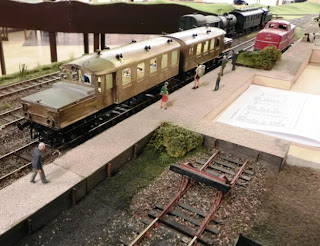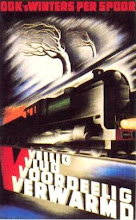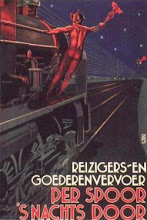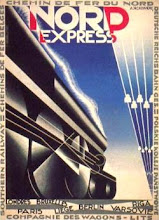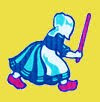Last year, I obtained a beheaded MTH PCC streetcar. It was complete, with only one detail missing; the plastic hood. Since, the C&LE box trailer needs a matching box motor and the gentleman of the Seashore Trolley museum was so friendly to send me the technical drawings of the 648 C&LE freight engine, I decided to try and convert the MTH PCC streetcar into this freight engine. One of the clear differences between the two is the larger truck to truck distance in the latter, so I had make a new under-plate to build the engine on. I decided to work with 1 mm (1/25th inch) Aluminium sheet. With the help of a precision saw and a drill I took the first step in making this box motor. In order to make the under-plate a bit more rigid, I will attach some brass L-profiles to the sides. This will help with fixing the new hood to this underplate and make it more sturdy. Well, there is still quiet a lot to do, but the first step is taken. Yesterday, I checked the electrical functions of the engine and fortunately they are all still working correctly.
Tuesday, November 22, 2011
Sunday, November 13, 2011
TCA MG Club cars 2011
Last week the TCA MG club cars arrived from Weaver. This year I bought the three-pack because it were Reading cars; 2-bay composite hoppers. Some hand-crafted coal-loads were made by Don and he sure did a great job. They do look awesome.
I hooked the cars up to the SW-1500 switcher and drove them around with some other Weaver cars I had accumulated over the years. The night express run slowly over the attic floor.
I hooked the cars up to the SW-1500 switcher and drove them around with some other Weaver cars I had accumulated over the years. The night express run slowly over the attic floor.
Sunday, November 06, 2011
Historic train film
A really special historic train movie has been placed on-line.
This movie was specially made in 1939 to celibrate 100 years of railways in the Netherlands. It is in Dutch and shows many steam engines, early electrical passenger trains, bridges and buildings, of which some are no longer present. Although most of the visitors to this blogsite will not understand the spoken and written language in this film, the pictures are universally understood by train enthusiasts all over the world. The total length is almost half an hour and hence this film can best be watched with a drink close at hand.
The films starts with a re-enactment of the first train ride in the Netherlands between Amsterdam and Haarlem in 1839. For this purpose, they specially rebuild the first steam engine that ever run (slowly) in the Netherlands. It is named "De Arend" (the eagle) and is now part of the collection of the Dutch railway museum.Then the film speeds to 1939 and shows what was regarded as modern trains back then.
For those of you, who would like to see something special, go fetch a drink and click on the link. Once on the local history site, click on the video on the top left hand corner and enjoy.
I specially like the idea that many of the pre-war toy trains that I cherish, run and restore are even older than than this film.
This movie was specially made in 1939 to celibrate 100 years of railways in the Netherlands. It is in Dutch and shows many steam engines, early electrical passenger trains, bridges and buildings, of which some are no longer present. Although most of the visitors to this blogsite will not understand the spoken and written language in this film, the pictures are universally understood by train enthusiasts all over the world. The total length is almost half an hour and hence this film can best be watched with a drink close at hand.
The films starts with a re-enactment of the first train ride in the Netherlands between Amsterdam and Haarlem in 1839. For this purpose, they specially rebuild the first steam engine that ever run (slowly) in the Netherlands. It is named "De Arend" (the eagle) and is now part of the collection of the Dutch railway museum.Then the film speeds to 1939 and shows what was regarded as modern trains back then.
For those of you, who would like to see something special, go fetch a drink and click on the link. Once on the local history site, click on the video on the top left hand corner and enjoy.
I specially like the idea that many of the pre-war toy trains that I cherish, run and restore are even older than than this film.
Monday, October 31, 2011
Lionel 289E running on the attic
Tuesday, October 18, 2011
Zutphen 15 & 16 Oct. scale zero meeting
Last weekend, the Dutch scale zero enthusiasts had their annual meeting in Zutphen. A real surprise for me was to see a large purple MTH box and the 5 CIWL passenger cars. They run on the large oval behind a classic Dutch steamer of the 3700 Class. MTH seems to have convinced the fine scaling zero-2-rail community with it price and quality.
It was a peaceful meeting of model train enthusiasts and various modellers showed their projects. Another large surprise was the "Free to take" (Gratis mee te nemen) text in front an expensive beautiful Dutch steamer, must either be a joke or a mistake.
And there was a three-railers corner. A friendly sales representative of Merkur, ETS and Lehnhardt taught me a bit about those Czech model trains. The large red passenger car for instance is sturdy, but still only 40 Euro, which compares pleasantly with other tin-plate brands.
All in all it was a very pleasant meeting and I am looking forward to the next one.
It was a peaceful meeting of model train enthusiasts and various modellers showed their projects. Another large surprise was the "Free to take" (Gratis mee te nemen) text in front an expensive beautiful Dutch steamer, must either be a joke or a mistake.
And there was a three-railers corner. A friendly sales representative of Merkur, ETS and Lehnhardt taught me a bit about those Czech model trains. The large red passenger car for instance is sturdy, but still only 40 Euro, which compares pleasantly with other tin-plate brands.
All in all it was a very pleasant meeting and I am looking forward to the next one.
Sunday, October 16, 2011
Final run
The old folding table layout was disassembled today. But before that actually happened the Lionel 289E engine and a small string of passenger cars 607, 603 and 604 made a tribute run over the small layout. Now what is left are photo's, screws, wires and tracks...
The new layout will have a wider radius outer circle, will be really level this time, larger and permanent.
Monday, October 10, 2011
Lionel 607 finished as 603
Today the light bulb wire was connected to the third rail contact and the light lit. The reassembly went really smooth. The decals on the red passenger car body "The Lionel Lines" were water transfers from Papa Les Trains. I did not have any "Pullman" or "603" decals left, so I made my own with "Avery Glas-Dekofolie", which is a locally available brand for making glass window decals on a sticky transparent plastic sheet basis.
The couplers are new and they were necessary, because the rusty 607 wreck came without any.
The highly glossy black roof paint allows me to see all the small dents that I missed when I was filling and sanding the big dents. Well, it ain't 100% smooth, but at least it is much better than how it was.Although some Lionel collectors might argue that I should have used 607 decals and should have used burgundy red inside of bright red, I like it better this way. First of all, it is much better of than how it was and I sure hope to see it running with the 604 and 607 I have already restored and ready.
The couplers are new and they were necessary, because the rusty 607 wreck came without any.
The highly glossy black roof paint allows me to see all the small dents that I missed when I was filling and sanding the big dents. Well, it ain't 100% smooth, but at least it is much better than how it was.Although some Lionel collectors might argue that I should have used 607 decals and should have used burgundy red inside of bright red, I like it better this way. First of all, it is much better of than how it was and I sure hope to see it running with the 604 and 607 I have already restored and ready.
Sunday, September 18, 2011
Lionel 607 painted
This weekend, I finished painting the Lionel 607 passenger car. I choose a middle red colour and not the more typical burgundy red colour. So, this passenger car will look more like the MTH remake than the original, but I just like this colour more. Last week, I already painted everything, but there was this one hair of half an inch that had landed on the wet black glossy paint of the roof.
Therefore, I had to redo the whole roof, but now I shines without this one curly hair.
I decided to assemble the window-pane in the car body and to put the roof on, just to see how the final result will look. There is still a couple of things to do. The axles still have some rust and need to be treated again. The wheels need to be polished better, to get rid off the last bits of black sooth.
Additionally, the lamp holder is severely rusted and it will be difficult to get it in a better state, because of all the grooves. Perhaps I will replace it with a new part. Well the couplers were also gone, so it will get some new shining couplers as well. The brass tank lids have some rust grooves and although it is polished and it shines, these grooves remain visible. A testomony of age, I would reacon.
Some blokes asked for it, so here is an additional picture of the All Nation Line C&LE box trailer kit in finished condition, well all but the couplers.
Therefore, I had to redo the whole roof, but now I shines without this one curly hair.
I decided to assemble the window-pane in the car body and to put the roof on, just to see how the final result will look. There is still a couple of things to do. The axles still have some rust and need to be treated again. The wheels need to be polished better, to get rid off the last bits of black sooth.
Additionally, the lamp holder is severely rusted and it will be difficult to get it in a better state, because of all the grooves. Perhaps I will replace it with a new part. Well the couplers were also gone, so it will get some new shining couplers as well. The brass tank lids have some rust grooves and although it is polished and it shines, these grooves remain visible. A testomony of age, I would reacon.
Some blokes asked for it, so here is an additional picture of the All Nation Line C&LE box trailer kit in finished condition, well all but the couplers.
Sunday, September 04, 2011
Lionel 607

It is more than two and a half years ago, since I choose to test my new sand blaster on a old rusty Lionel 607 passenger car, which was scooped up from Ebay some 3 years ago. Since then I derusted, sanded and disassembled the passenger car slowly, working occasionally on it. But now that I got my new work shed sorted, it was the first project to finish, from the long list of restorations that still wait for my attention.
After all the paint was removed from the body, it became apparent that this passenger car must have been composed from two non identical halves. One tin-plate side panel with rivets and one smooth. Also at the corners of the car, smoothened solder residues were visible. So, this is a car with some history that already received a major renovation in the past and is now up for its second rejuvenation. On the head ends of the car the guiding rails for the couplers were broken off. So, I fixed this with 1 mm brass wire and some very thin brass plate cuttings. I soldered the lot in position, sanded it and used some solder and plaster to smoothen the edges and sanded the lot again.
The roof had 3 dents, which were crudely filled with solder and then smoothened with filler, sanded, smoothened with filler and sanded again.
Today was a hot day and I could spray paint primer paint on it. And I must say that I am quiet happy with the result; a smooth roof and nice car body.
Working with this passenger car, you start to wonder what this car must have experienced since the twenties of the last century. Nevertheless, its future looks bright again; it will return in toy train service soon.
Monday, August 29, 2011
Old steamer passing by

This weekend we had a superb view on a steam engine running through the back yard. The whistle blew near all cross-overs and announced its arrival. Then it passed and left a cloud of coal-scented smoke in the back garden.
This smooth steamer is the jewel of the VSM; the German 23076 steamer.
Tuesday, June 21, 2011
Applying decals

The paint work in the trailer kit did have some flaws, so I decided to sand them off and spray paint again. The paint job turned out much better. Now, I am busy applying the 0 scale CL&E freight trailer decals, I obtained from Shoreline decals. They work easy and look good. Just need to figure out where to place them all, with the help of some old pictures of the original and the drawings from the Traction handbook. And then the last steps will come: a dull coat to blend the decals in and the scratch building of some couplers.
Wednesday, April 20, 2011
Painting the All nation line traction trailer




The weather is excellent for some spray painting in the garden. First the box trailer was primed with a neutral grey paint. Then the roof was spray coated with dull black and the body of the trailer was painted "Maroon". This is a typical American colour which you will not find easily in Europe, but fortunately there is the Japanese brand Tamiya that globalises paint colours and brings American colours to Europe. Well, I am reasonably happy with the result. Just need to dust the car next time I make a picture, because there is too much tree pollen in the air right now.
Sunday, March 27, 2011
Lazy sunday afternoon

Spring has finally arrived. This is great news, so I can finally let my steamers smoke with the window open. We played a bit with the trains, recharged the MTH engine batteries by giving some AC current while standing idle. So, we could listen to the various announcements coming from the SW1500 Switcher: "check for foamers on the up yard". Strange language, must be American.
The body work for the All Nation line box trailer is almost finished, just add some more steps and a brake wheel and we can start plastering, sanding and painting. I will need a new brake wheel. I tried to solder a little brass rod to the wheel and I noticed that the wheel was made from cast tin and it melted away faster than I could remove my soldering gun. Pretty daft. Time for a drink!
I am planning to use the decapped MTH PCC streetcar as basis for scratch building a #648 C&LE freight engine. The librian of the trolley museum in Maine was so kind to supply me with the technical drawings, so here comes another project. I am planning to work with tin plate and wood to make the body. Most importantly, I will have to start by making a new, larger base plate, for this engine will be longer than the PCC streetcar. Plenty of things to do, I would think.
Monday, March 07, 2011
The box trailer starts to get shape



After a few more evenings the All Nation Line kit of the box trailer car is starting to get shape. The facia boards were glued on and the door posts were glued in.
This box trailer will get operating doors and hence I fiddled to get two brass U-profiles glued in the right position to make the doors slide. Some wood had to be removed in order to lower the U-profiles in position.
Finally, the roof was shaped and it got a more rounded of appearance with the help of a file, a bit of sanding paper and some persistence.
Sunday, February 27, 2011
Progress on the box trailer car


These rainy evenings are good for building the All Nation Line kit of the box trailer car. I read the instructions and the hints of other wooden kit builders on the web and decided to build the undercarriage first. So I started with cutting the wood of the undercarriage and glue the bolsters in place. Then I formed the end filler blocks and glued them on. Then the queen posts and brake cilinder were glued on with epoxy glue. I followed Dan's advise and did not use the brass wire for the truss rods but used Nylon 0,5 mm wire instead, which I glued to the backside with epoxy. Then the turnbuckles were glued on the centre of the wires.
Then it was time to turn the car around and assemble the top parts. Since the undercarriage width was about 3 mm short of what the drawings indicated that it should be and also compared to the size of the other parts, I decided to glue 1.5 mm wooden spacers between the undercarriage and the scribed wooden side panels. The same was done with the blocks on the front and back side of the car. Well, I am happy that it starts to look like a train car now.
The level of the brake rigging and the door handles is not very high and I thinking about fiddling around with some paper and wood to scratch build that a bit better. Then the question is, how did the brake system of such a interurban freight car look like?
Tuesday, February 22, 2011
MTH in a Dutch model train shop
The European model trains that MTH has announced in scale zero have been noticed in mainland Europe. The French golden arrow Chapelon engine was considered a great success by many, with perhaps a few issues, such as the tender-to-engine distance, but nevertheless a beauty. Now MTH claims to also produce a Bavarian steamer, a Swiss crocodile and a Traxx rectifier engine. The latter will be relative affordable in comparison to what the zero fine scalers are used to pay for their engines at Fulgurex, Lenz, Lemaco, Philotrain, etc. Also a matching gondola and tank car have been announced and the lot made a few heads turn. So, I was not too surprised when the news came out that a local hobby shop named Modeltreinexpress in Vlaardingen has announced to start dealing in MTH trains. Obviously, the far majority that is being announced are the European 2-rail models, but still it is a step in the good direction in my humble opinion. Let's hope that the supply delays will be dealt with and that these models will start to arrive in this shop. Although it is unlikely that this 3 railer will ever buy a 2 rail engine, I still like the fact that MTH is now being sold in a regular model train shop in the Netherlands.
The list of Dutch shops that have announced to start selling MTH in scale zero has grown; also Wentink hobby in Arnhem has placed MTH on their list. I understood that the first MTH Traxx engines in scale zero have arrived in the Netherlands. Good news, I would reacon.
The list of Dutch shops that have announced to start selling MTH in scale zero has grown; also Wentink hobby in Arnhem has placed MTH on their list. I understood that the first MTH Traxx engines in scale zero have arrived in the Netherlands. Good news, I would reacon.
Thursday, February 03, 2011
Starting of with the All Nation line box trailer kit


About one and a half years ago, I purchased an All Nation Line kit #A-110 for a C&LE box trailer. Initially the kit appeared complete, but a closer inspection learned that one of the four scribed wood side panels lacked. The lines of the scribed wood are very fine and roughly only 2 millimeters apart. The side panels are 3 millimeter thick and since this is a standard size in balsa wood, I used a piece of 3 mm balsa wood and tried to engrave fine lines in the balsa with a sharp hobby knive. I could not reach the detail level required; the lines were not straight and 2 mm apart was difficult with 1 mm incisions. So, I left that idea and started with fine paper strips glued with wood glue on a 3 mm balsa panel. Well, that did work. I got a good replicate of a scribed wood panel. After painting the lot with tuscan brown the differences between the original and the self-made panel will be hard to spot. Some photo's show the progress with the task of glueing the fine paper stripes.
Now I can finally start building the kit. Because of the beautiful original American toy-train-lingo, I copied the text of the original instructions underneath.
Instructions for C&LE Box trailer
Kit # A-110
1. Glue filler blocks at end of floor.
2. Shape roof and floor ends as shown, nail and glue end blocks to same.
3. Cut out door openings in scribed sides and glue to car body.
4. Glue scribed wood to end of car.
5. Glue facia boards at eaves to car as shown.
6. Form tinplate and drill holes for nut and washer castings. Pin to car and attach nut and washer castings as shown.
7. Drill 3/16" brass I beam so that it can be pinned to car. Solder Queen posts to beam and attach to car. Add .032 wire for truss rods and solder turnbuckle in place. Glue wood bolsters in place at this time.
8. Make doors from 1/16" scribed wood. Glue doors in place or if you wish, you can make an operating door. Glue 1/8" quarter round to sides as shown in drawing. Threshold is made from 5/32" strip wood.
9. Attach all hardware, such as handgrabs, steps, brake wheel and etc. as shown.
10. Paint car and attach Arch Bar Trucks.
Fortunately for me, there are two helpful internet sites with hints and tips on how to build wooden train car kits. Dan clearly advises to start with the underfloor details: the bolsters, brake rig and queen posts and to use Nylon wire in stead of Brass wire for the truss rods. And George Riley of the Railroad model craftsman also advises to start with the undercarriage and seal the wooden parts.
Subscribe to:
Posts (Atom)




